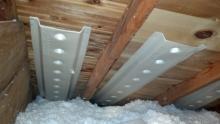- Energy Testing
- Insulation
- Windows
- Radon Mitigation
- Energy Solutions
- Attic Air Sealing
- Attic Insulation
- Attic Ventilation
- Rim Joists: Insulation and Air Sealing
- Rooms above garages
- Sidewalls (Open & Closed Cavities)
- Sloped & Vaulted Ceilings
- Bathroom Exhaust Fans
- Basement Walls
- Story-and-a-half Homes: Cape Cod, Salt Box, Modified A-Frame, Bungalow
- Crawlspace Moisture Control & Insulation
- Insulation Cantilevered floors
- Ice Dams
- Rebates & Incentives

After air sealing and insulation, proper ventilation is the third prong in our comprehensive approach to a high performance attic. Ventilation is key to the durability of the attic and roof system, and will keep your attic cooler in the heat of summer and carry off excess heat and moisture in the winter.
Start at the Eaves
Proper ventilation starts outside at the eaves, or the part of the roof that meets the wall of a building. Perforated soffits allow cool, outdoor air to enter the attic at the eaves. Too few vents on the exterior can starve the attic of this ventilation air, so additional vents may need to be cut in to ensure proper flow.
Attic Ventilation Chutes
Back up in the attic, ventilation chutes made of foam, plastic, or cardboard ensure that ventilation air is unimpeded as it makes its way up into the attic. Installing chutes here is critical. They help to mitigate ice dams by keeping the most vulnerable part of the roof deck cool, so ice doesn’t melt and then start to build up and damage the shingles. Existing homes often require additional chutes to be added, or that existing chutes be extended to ensure adequate airflow.
High Side Ventilation
As cool ventilation air warms in the enclosed attic, it needs an escape route to carry off excess heat. This is where high side ventilation comes in. This ventilation can take the form of either several roof vents or a continuous ridge vent strip at the peak of the roof. If high side ventilation is restricted, air flow through the attic will also be restricted. In some homes, passive ventilation on the high side of the roof may need to be added.
Note: Why Power-Ventilation is Not Ideal
Roof mounted, “power-ventilation” attic fans, capable of flow rates of over 2,000 cubic feet per minute (picture your furnace's blower motor on full blast) are often sold under the guise of saving on cooling bills in the summer and preventing ice dams in the winter. In reality, however, these attic fans tend to drastically de-pressurize the attic. This disturbs insulation and aggressively draws conditioned air up and out of the home. Passive ventilation (the type of ventilation we use, described above) has the same benefits as active ventilation, but without the energy penalty and increased air leakage associated with power-ventilation. It is for these reasons that we generally discourage the use of active ventilation in most attics.
Get in touch to set up your attic ventilation inspection and upgrades.
Contact UsEnergy Assessments for $450 or less
Schedule your FREE Home Estimate
Testimonials
Quent & Barb B., New Richmond, WI
We contacted St. Croix Energy Solutions and scheduled an appointment to fix all the issues and they were very professional and knowledgeable. In the end, our house is no longer leaking our heat to the outside! The bathroom fan is amazing – can't even hear it run! Thank you so much for taking care of our home. We appreciate having this kind of service available to everyone in our area.
